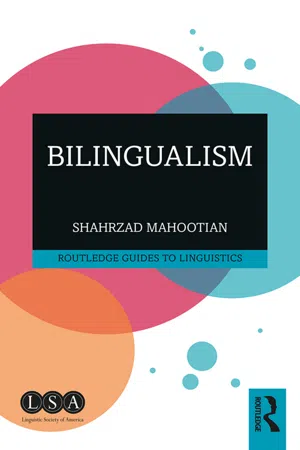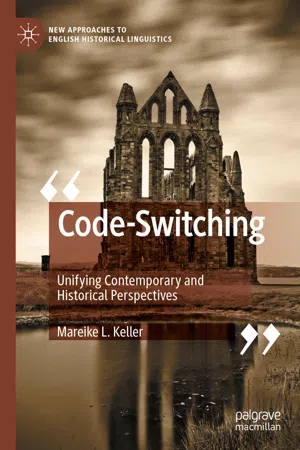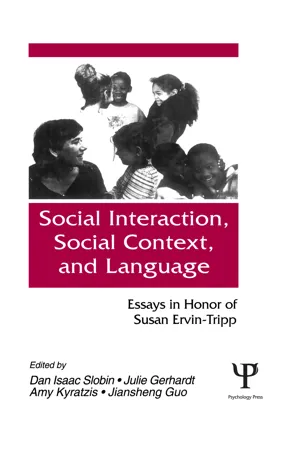Holmes Code Switching
Holmes Code Switching refers to the linguistic phenomenon where a speaker alternates between two or more languages or dialects within a single conversation or interaction. This practice is often influenced by social and cultural factors, and can serve various communicative functions such as expressing identity, solidarity, or emphasizing a particular point. It is a common feature in multilingual communities and is studied within the field of sociolinguistics.
7 Key excerpts on "Holmes Code Switching"
- eBook - ePub
Codeswitching in the Classroom
Critical Perspectives on Teaching, Learning, Policy, and Ideology
- Jeff MacSwan, Christian J. Faltis, Jeff MacSwan, Christian J. Faltis(Authors)
- 2019(Publication Date)
- Routledge(Publisher)
...Sociolinguists have studied the discourse, social motivation, and conversational contributions of codeswitching, detailing the ways in which bilinguals use language switching to achieve specific conversational effects and perform their linguistic identities. Researchers concerns with the underlying linguistic structure of codeswitching—or the grammar of codeswitching —have labored to reveal the specific mechanisms at work in defining the structure of language mixing itself, and showing in the course of doing so that the underlying grammar of codeswitching gives evidence of a rich and complex system of rules, every bit as impressive as the rules of monolingual grammar. These rich traditions of basic scientific research have long provided a basis for pedagogical inquiries into language mixing in classroom settings. So, too, the present chapter has sought to provide an overview of the theoretical foundations of codeswitching research to help undergird our understanding of critical questions in bilingual teaching and learning, taken up in the chapters that follow. Acknowledgments Holly Cashman provided assistance with Table 1.1. Christian J. Faltis, Karen Feagin, Katharine Glanbock, and Lijuan Shi provided detailed comments on an earlier draft of this paper, which resulted in substantial improvements. Many thanks. Note 1 The monolingual/bilingual distinction is itself an idealization. As Roeper (1999, 2016) noted, we are all multilinguals. See MacSwan (2017) for discussion. References Abney, S. P. (1987). The English noun phrase in its sentential aspect. Doctoral dissertation, MIT, Cambridge, MA. Alfonzetti, G. (1998). The conversational dimensions in code-switching between Italian and dialect in Sicily. In P.Auer (Ed.), Code-switching in conversation: Language, interaction and identity (pp. 180–214). London: Routledge. Auer, P. (1984). Bilingual conversation. Amsterdam, Netherlands: John Benjamins. Auer, P. (1995). The pragmatics of code-switching: A sequential approach...
- eBook - ePub
Bilingualism in Schools and Society
Language, Identity, and Policy, Second Edition
- Sarah J. Shin(Author)
- 2017(Publication Date)
- Routledge(Publisher)
...This would sometimes entail the use of features that are perceived by some speakers as unusual, such as “pizza mo two minutes coming”. Researchers argue that this type of language mixing does not have any local meaning, as traditional code-switching studies have tried to show. In this type of spontaneous, frequent, high-density language contact, it is not possible to predict whether someone will code-switch at any given point or whether two people with similar code-switching habits will both code-switch on the same occasion (Auer, 1999; He, 2013; Li, 2011). There is no discernible cognitive, contextual, and conversational-sequential motivation behind the switches. In other words, code-switching takes place for no apparent reason. Agnes He’s (2013) data from Chinese heritage language speakers show that the switches are: 1) not guided by any external principle or source, 2) unplanned, evolving as the interaction unfolds, and 3) always different and unpredictable. She observes that the switches are “a collage and calibration of holistic resources (phonemic, morpho-phonemic, syntactic, prosodic, episodic, sequential) from the entire linguistic repertoire simultaneously accessible to Chinese heritage language speakers, resulting in innovative and invigorating multi-performances that are based on their multi-competence” (He, 2013: 314). Overall, the recent rise of new terms celebrating multilingual performance is a welcome development given that bilingual students have too long been penalized for what they cannot do, rather than praised for what they can do. Terms like “translanguaging” and “flexible bilingualism” help educators see the importance of drawing from multiple languages and modalities in the classroom and encourage teachers to take a holistic approach that takes into account all of the languages in the learner’s linguistic repertoire...
- eBook - ePub
- Shahrzad Mahootian(Author)
- 2019(Publication Date)
- Routledge(Publisher)
...Although switching has at times been associated with the loss of one language, many researchers believe that codeswitching is a natural consequence of ability and competence in more than one language and, accordingly, should not automatically be regarded as language deficit, loss, or shift. As discussed in previously, language shift or loss is a result of multiple social variables (i.e., lack of support for the speech community, lack of valorization of the language, etc.). In this chapter, we learn more about using multiple-language discourse, choosing between languages, and the social and grammatical rules that guide switches and choices. 3.1 Managing Multiple Languages We know that all languages have grammars, rules that guide speakers to produce well-structured, acceptable sentences and steer them away from generating unacceptable utterances. Some of these rules are overtly taught, but most are learned as we progress through the various stages of language acquisition that begin in infancy. So what happens when the brain has more than one grammatical system to manage? To start our investigation, let’s begin with some fundamental terms, definitions, and examples. Code —In the context of bilingualism, code refers to languages and their varieties. Therefore, Japanese is a code as is Hebrew, French, Thai, and so on. Codeswitching —Codeswitching, also written as code-switching, refers to the act of changing from one language or dialect to another. It can be defined as the systematic use of two or more languages or varieties of the same language during oral or written discourse. It’s a common speech behavior, most often used in informal, casual contexts. Codeswitching can occur intrasententially, within a sentence, including the switching of a single word, prefix, or suffix. It can also occur intersententially, between sentences at the discourse level...
- eBook - ePub
- David Graddol, Dick Leith, Joan Swann, Martin Rhys, Julia Gillen, David Graddol, Dick Leith, Joan Swann, Martin Rhys, Julia Gillen(Authors)
- 2020(Publication Date)
- Routledge(Publisher)
...This no doubt reflects researchers' own backgrounds and the dominance of English within academic life, as well as the prevalence of English as a Second (or third, etc.) language in so many parts of the world. Researchers have been interested both in the meanings and functions of codeswitching and in how switching works linguistically. We consider both aspects in the sections that follow. Activity 7.4 Why switch? Reading B, 'Codeswitching with English: types of switching, types of communities', is from Carol Myers-Scotton's paper on codeswitching in 2Imbabwe and Kenya. (Remember that Chapter I, Section 1.4, discussed patterns of language use in Kenya - focusing on the use of Kiswahili, English and Sheng; you may find it useful to refer back to this.) Work through Reading B now, noting down what the researcher has to say about motivations for codeswitching. Our comments are included in the discussion that follows this activity. The reading suggests that, like the use of different speaking styles by monolingual speakers, bilingual codeswitching is meaningful: it fulfils certain functions in an interaction, Myers-Scotton's markedness model suggests that particular codes (in this case, languages) are associated with, and therefore expected in, particular contexts (her Example 1 shows the use of Swahili with a security guard and English with a receptionist). Codeswitching itself may be the unmarked (expected) choice in certain contexts (as in Myers-Scotton's Examples 2 and 3). A speaker's choice of language has to do with maintaining or negotiating a certain type of social identity. The use of a particular language also gives access to rights and obligations associated with that identity. Codeswitching between languages allows speakers (simultaneous) access to rights and obligations associated with different social identities...
- eBook - ePub
- Jeff MacSwan(Author)
- 2022(Publication Date)
- Multilingual Matters(Publisher)
...Clevedon: Multilingual Matters. Heller, M. (1995) Code-switching and the politics of language. In L. Milroy and P. Muysken (eds) One Speaker, Two Languages: Cross-disciplinary Perspectives on Code-switching (pp. 158–174). New York, NY: Cambridge University Press. Higby, E., Kim, J. and Obler, L.K. (2013) Multilingualism and the brain. Annual Review of Applied Linguistics 33, 68–101. Hopper, P. (1987) Emergent grammar. Proceedings of the Thirteenth Annual Meeting of the Berkeley Linguistics Society 13, 139–157. Hymes, D. (1971) Introduction, part III. In D. Hymes (ed.) Pidginization and Creolization of Languages (pp. 65–90). London: Cambridge University Press. Hymes, D. (1974) Foundations in Sociolinguistics: An Ethnographic Approach. Philadelphia, PA: University of Pennsylvania Press. Jakobson, R. (1960) Linguistics and poetics. In T. Sebeok (ed.) Style in Language (pp. 350–377). Cambridge, MA: MIT Press. Jaspers, J. (2018) The transformative limits of translanguaging. Language and Communication 58, 1–10. Jørgensen, J.N. (2008) Polylingual languaging around and among children and adolescents. International Journal of Multilingualism 5 (3), 161–176. Jørgensen, J.N. (2010) Languaging: Nine Years of Poly-lingual Development of Young Turkish - Danish Grade School Students. Copenhagen: Faculty of Humanities, Copenhagen University. Jørgensen, J.N., Karrebæk, M.S., Madsen, L.M. and Møller, J.S. (2011) Polylanguaging in superdiversity. Diversities 13 (2), 23–37. Kachru, B. (1983) The Indianization of English: The English Language in India. Delhi: Oxford University Press. Kachru, B. (1987) The bilingual’s creativity: Discoursal and stylistic strategies in contact literatures. In L.E. Smith (ed.) Discourse across Cultures: Strategies in World Englishes (pp. 125–140). New York, NY: Prentice–Hall. Kharkhurin, A.V. and Li, W. (2015) The role of code-switching in bilingual creativity. International Journal of Bilingual Education and Bilingualism 18 (2), 153–169. Kootstra, G.J...
- eBook - ePub
Code-Switching
Unifying Contemporary and Historical Perspectives
- Mareike L. Keller(Author)
- 2020(Publication Date)
- Palgrave Pivot(Publisher)
...I am convinced that collaboration between the different branches of multilingual studies holds powerful unmined potential for enhancing our understanding of code-switching, and I hope that this book can help to promote an integrated, interdisciplinary approach to exploring the interaction of languages as a synchronic and diachronic phenomenon. References Auer, Peter, and Raihan Muhamedova (2005). ‘Embedded Language’ and ‘Matrix Language’ in Insertional Language Mixing: Some Problematic Cases. Italian Journal of Linguistics 17(1): 35–54. Çetinoğlu, Özlem, Sarah Schulz, and Ngoc Thang Vu (2016). Challenges of Computational Processing of Code-Switching. In Proceedings of the Second Workshop on Computational Approaches to Code Switching, 1–11. Austin, TX: Association for Computational Linguistics. Dinkova-Bruun, Greti (2011). Medieval Latin. In A Companion to the Latin Language, edited by James Clackson, 284–302. Malden, MA: Wiley-Blackwell. Keller, Mareike (forthcoming). Developing a Structural Template for Historical Code-Switching. In Historisches Codeswitching mit Deutsch, edited by Erika Glaser, Michael Prinz, and Stefania Ptashnyk. Berlin: De Gruyter. Kootstra, Gerrit Jan (2015). A Psycholinguistic Perspective on Code-Switching: Lexical, Structural, and Socio-Interactive Processes. In Code-Switching Between Structural and Sociolinguistic Perspectives, 39–64. Berlin and Boston: De Gruyter. Kopaczyk, Joanna, Matylda Włodarczyk, and Elżbieta Adamczyk (2016). Medieval Multilingualism in Poland: Creating a Corpus of Greater Poland Court Oaths (ROThA). Studia Anglica Posnaniensia 51: 9–35. Crossref Labov, William (1994). Principles of Linguistic Change, Volume 1: Internal Factors. Oxford: Blackwell. McFadden, Thomas (2014). Why Nominative Is Special: Stem Allomorphy and Case Structures. Paper presented at the GLOW37, Brussels. McLelland, Nicola (2004)...
- eBook - ePub
Social interaction, Social Context, and Language
Essays in Honor of Susan Ervin-tripp
- Dan Isaac Slobin, Julie Gerhardt, Amy Kyratzis, Jiansheng Guo, Dan Isaac Slobin, Julie Gerhardt, Amy Kyratzis, Jiansheng Guo(Authors)
- 2014(Publication Date)
- Psychology Press(Publisher)
...Her research was as specified in her title, i.e., a study of the interaction of language, topic, and listener; she reported that each had independent effects and that incongruent combinations (e.g., being required to speak in English on a "Japanese topic" with a Japanese interlocutor) generated difficulties for speakers. While SET's findings were based on elicitation in an experimental interview design, the results were fully consonant with those reported in Gumperz's (1964) contribution with reference to situational switching, i.e., he reported that code (dialect in this case) choice was determined by topic and by social relations among interlocutors. His addition to the theoretical formulation of the phenomena under consideration was his identification of a variety of switching related not directly to topic/situation but rather contrastively so, i.e., the marking of talk metaphorically. A substantial proportion of the writing on language variation in use in the two decades following the publication of the special issue of the Anthropologist was devoted to working out details of the paradigm-setting pieces by SET and by Gumperz. In the 1980s, however, a new literature about meanings of code selection and code variation began to appear in sociolinguistics; I can mention only three exemplars which appear to me to make theoretical claims of quite different scope. Duranti (1990) is an intriguing study of code-switching between what are known as "good" and "bad" Samoan (with a few short stretches in English) in multiparty talk involving the ethnographer, his stepson, and a Samoan couple. He observes that it is often in situations where visitors are present that those studied may be constrained to resort to more subtle and indirect forms of interaction — whether in engaging in conflict or in, for example, instructing children about appropriate behavior; the verity of this observation is known to all middle class American readers of this note...






